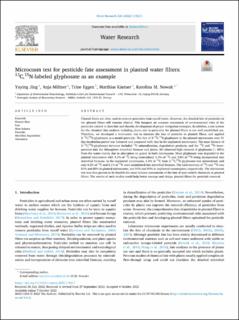| dc.contributor.author | Jing, Yuying | |
| dc.contributor.author | Miltner, Anja | |
| dc.contributor.author | Eggen, Trine | |
| dc.contributor.author | Kästner, Matthias | |
| dc.contributor.author | Nowak, Karolina M. | |
| dc.date.accessioned | 2022-12-23T19:51:31Z | |
| dc.date.available | 2022-12-23T19:51:31Z | |
| dc.date.created | 2022-11-24T10:40:43Z | |
| dc.date.issued | 2022-11-01 | |
| dc.identifier.citation | Water Research. 2022, 226 . | en_US |
| dc.identifier.issn | 0043-1354 | |
| dc.identifier.uri | https://hdl.handle.net/11250/3039466 | |
| dc.description.abstract | Planted filters are often used to remove pesticides from runoff water. However, the detailed fate of pesticides in the planted filters still remains elusive. This hampers an accurate assessment of environmental risks of the pesticides related to their fate and thereby development of proper mitigation strategies. In addition, a test system for the chemical fate analysis including plants and in particular for planted filters is not well established yet. Therefore, we developed a microcosm test to simulate the fate of pesticide in planted filters, and applied 2-13C,15N-glyphosate as a model pesticide. The fate of 2-13C,15N-glyphosate in the planted microcosms over 31 day-incubation period was balanced and compared with that in the unplanted microcosms. The mass balance of 2-13C,15N-glyphosate turnover included 13C mineralization, degradation products, and the 13C and 15N incorporation into the rhizosphere microbial biomass and plants. We observed high removal of glyphosate (> 88%) from the water mainly due to adsorption on gravel in both microcosms. More glyphosate was degraded in the planted microcosms with 4.1% of 13C being mineralized, 1.5% of 13C and 3.8% of 15N being incorporated into microbial biomass. In the unplanted microcosms, 1.1% of 13C from 2-13C,15N-glyphosate was mineralized, and only 0.2% of 13C and 0.1% of 15N were assimilated into microbial biomass. The total recovery of 13C and 15N was 81% and 85% in planted microcosms, and 91% and 93% in unplanted counterparts, respectively. The microcosm test was thus proven to be feasible for mass balance assessments of the fate of non-volatile chemicals in planted filters. The results of such studies could help better manage and design planted filters for pesticide removal. | en_US |
| dc.description.abstract | Microcosm test for pesticide fate assessment in planted water filters: 13C,15N-labeled glyphosate as an example | en_US |
| dc.language.iso | eng | en_US |
| dc.publisher | Elsevier Ltd. | en_US |
| dc.rights | Attribution-NonCommercial-NoDerivatives 4.0 Internasjonal | * |
| dc.rights.uri | http://creativecommons.org/licenses/by-nc-nd/4.0/deed.no | * |
| dc.title | Microcosm test for pesticide fate assessment in planted water filters: 13C,15N-labeled glyphosate as an example | en_US |
| dc.title.alternative | Microcosm test for pesticide fate assessment in planted water filters: 13C,15N-labeled glyphosate as an example | en_US |
| dc.type | Peer reviewed | en_US |
| dc.type | Journal article | en_US |
| dc.description.version | publishedVersion | en_US |
| dc.rights.holder | © 2022 The Authors | en_US |
| dc.source.pagenumber | 9 | en_US |
| dc.source.volume | 226 | en_US |
| dc.source.journal | Water Research | en_US |
| dc.identifier.doi | 10.1016/j.watres.2022.119211 | |
| dc.identifier.cristin | 2079830 | |
| dc.relation.project | Norges forskningsråd: 272309 | en_US |
| dc.relation.project | EC/H2020/826244 | en_US |
| dc.source.articlenumber | 119211 | en_US |
| cristin.ispublished | true | |
| cristin.fulltext | original | |
| cristin.qualitycode | 2 | |

